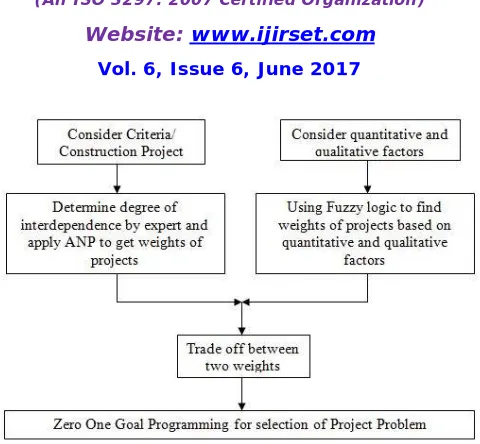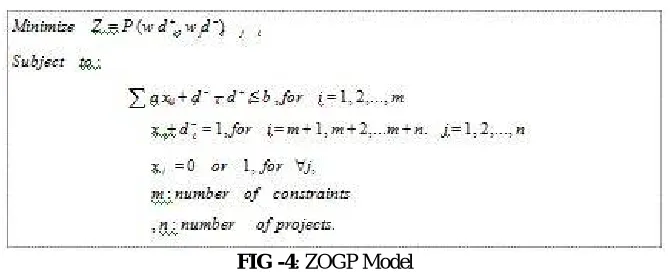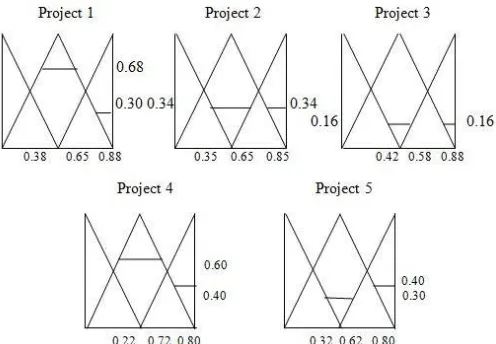Project Selection Technique Using ANP and
Fuzzy Logic in Construction Industry
Syed Azhar Hussain,
Associate Professor, Department of Civil Engineering, Guru Nanak Institutions Technical Campus, Hyderabad, Telangana, India
ABSTRACT: Construction projects are expensive and require considerable human input, money and time resources which are limited and often considered as multi-criteria decision-making (MCDM) for a solving method. MCDM problems of project selection normally have various aspects like dependence, interdependencies among criteria, sub criteria, qualitative and quantitative factors. Most of the time decision makers consider these aspects separately even though these aspects are simultaneously incorporated. In this paper we consider interdependencies among criteria, sub criteria, qualitative and quantitative factors and proposed a hybrid method using analytic network process (ANP) and fuzzy logic. We then propose a goal programming model to conduct an optimization for the project selection problems interpreted by a hybrid concept. Finally, a numerical example is conducted as verification purposes. The proposed algorithm in this paper is useful to researchers and industry professionals. Researchers may consider this study as focus of attention for exploring other applications of ANP and fuzzy logic. Industry professionals may adopt the weighted criteria for direct project selection or apply the ANP method to prioritize their own set of selection criteria.
KEYWORDS:Project selection, Multi-Criteria Decision-Making (MCDM), Analytic Network Process (ANP), fuzzy logic, Goal Programming Introduction
I. INTRODUCTION
Selection of a project constitutes one of the major problems faced by managers today in construction industry in India. Decision of selecting an engineering, construction or research and development project is often fundamental for business survival. Such decisions usually involve prediction of future outcomes considering different alternatives. As these predictions are not known with certainty, project managers are often faced with some degree of uncertainty. Modern businesses are exposed to be more severe and challenging environment than ever before. The increasing volatility in interest and exchange rates, lifting trade barriers and development of new technologies result in a high level of uncertainty in managerial decision making.
Fig -1: An overview of the proposed methodology
1.1 Literature Review
In construction industry numerous techniques have been proposed in past recent years for project selection problems. Heidenberger and Stummer (1999) [1] surveyed of quantitative techniques for research and development for project selection problem. Most of the procedures listed can be applied for evaluating of construction and engineering projects. Main objective of this paper is to propose a hybrid method using ANP (analytic network process) and fuzzy logic to represent both aspects simultaneously. An ANP method is used to reflect the interdependence which exist in mul criteria in a project selection. Fuzzy logic is applied to consider qualitative and quantitative factors and find weights among projects.
After obtaining the weights, a goal programming (GP) model is proposed to conduct an optimization for the project selection problems interpreted by a hybrid concept. This paper also demonstrates how the proposed hybrid method combining ANP, a fuzzy logic, and a GP method can effectively solve a project selection problem in construction industry. Following figure illustrates an overview of the model.
FIG -2: Sub and main quantitative and qualitative factors
II. PROPOSED METHODOLOGY
The proposed method includes the following five steps.
Step 2: Using ANP model based on the basic 1-9 scale of Saaty’s with reciprocals, in a project comparison matrix. Determine the degree of impact or influence between the criterions by pair wise comparisons.. The degree of impact or influence between the criterions is simulated in Fig. 3.
FIG -3: Interdependent relationship among the criterion
AHP is suitable for solving the problem of independence on alternatives or criteria and ANP is useful for solving problem of dependence among criteria or alternatives.
Step 3: Use fuzzy logic to consider about qualitative and quantitative factors. Chen [2] used fuzzy logic Zadeh [15] to evaluate quantitative factor and qualitative factors but the difference between projects is not much and just suitable when choosing one of two projects did not mention about interdependence among criterion and projects.
Step 4: Determine the overall prioritization of all the projects under consideration.
In real world the weight trade-off function should be: w=f(wANP,wfuzzy). In this paper we proposed a simple hybrid method that can combine weight between ANP and fuzzy logic as follow:
w=wANP*wfuzzy Step 5: Zero One Goal Programming (final step).
The ZOGP model for project selection can be stated as follows (Lee [4]):
FIG -4: ZOGP Model
or when xj=0, then do not select the jth construction project, aij = the jth construction project usage parameter of the ith resources, and bi=the ith available resource or limitation factors that must be considered in the selection decision. The ZOGP model bases the selection of the construction projects xj on the ANP and Fuzzy logic which determined weights of wj for corresponding di−. The larger the wj, the more likely the corresponding construction project will be selected.
After having weights of projects we used goal programming for optimization problem wherein you have to choose some construction projects that have to satisfy some constraints. Most of the constraints in real world are of linear constraints. When we select some project we have to satisfy some goals.
Case Study
In case study we consider prioritizing five construction projects on the basis of four criteria as follows: (1) Contract Value (CV),
(2) Paying Capacity of Client (PC) (3) Technical Staff (TS)
(4) Skilled Labours (SL)
Marc’s [7] example was assumed that these four criteria are independent. However, interdependence always exist among these four criteria. The interdependence relationship or network structure among the criteria which is shown in Fig. 5 based on discussion of experts. Assumption that after ANP step (Lee [4]) we get weights of project base on criteria as follow:
wANP (p1, p2, p3, p4, p5) = (0.16, 0.220, 0.260, 0.152, 0.208).
But ANP does not consider about many important quantitative and qualitative factors as probability of success, potential risk, suitability and cost of project. We used Fuzzy step to get weights of projects (that considers about many important quantitative and qualitative factors) and used these weights to adjust parameters after ANP step.
Based on qualitative and quantitative factors of five projects Theoretical data bout these factors is recorded in the following table.
Table -1: THEORETICAL DATA ABOUT MAIN QUALITY FACTORS OF FIVE PROJECTS
We can think that probability of success can be low, medium or high. But we can also think that probability of success is equal 0.4 then it is quite medium a little low, and if probability of success is equal 0.9 then it is quite high, a little medium. Although the membership function for each linguistic term does not have to be in symmetric triangular form, but theoretically we can use the symmetric triangular form for all terms to demonstrate method to get weighted of project that base on quantitative and qualitative factors:
Short -2x+1 0.0 ≤ a ≤ 0.5 LIST OF
PROJECTS QUALITATIVE FACTORS Probability of Success Project Duration (months)
Project Cost (crores) Rs
Medium 2x 0.0 ≤ a ≤ 0.5
-2x+1 0.0 ≤ a ≤ 0.5
Large 2x+1 0.0 ≤ a ≤ 0.5
We used the same method of Chen to find Potential Risk, Feasibility and Suitability of Project and then get overall ratings for five projects.
A. Inference Process from Development Time to Potential Risk
The normalized project duration (0.83) for project 1 triggers two terms: “medium” and “high”. Note again that the terms for each linguistic variable may not be the same. For simplicity, we assumed that the terms can share the same membership function. So the membership functions for “long” and “large” are the same and membership functions for “short” and “small” are the same.
FIG-5: Inference Process from Project Duration to Potential Risk The inference rules are as follows:
if PD = Medium then R = Medium if PD = Short then R = Low if PD = Long then R = High
The value of COG be calculated with this formula
FIG-6: Formula for COG calculation Results of Potential Risk of Project are shown in Table II.
B. Inference Process from Probability of Success to Feasibility
Two terms, “medium” and “high,” are applicable when the input values for probability of success are plugged into the system. Hence, two rules were fired:
If PS = Medium then F = Medium If PS = High then F = High
Where PS is probability of success and F is feasibility.
FIG-7: Inference Process from Probability of Success to Feasibility We have Feasibility of project 1 is 0.623 based on Fig. 6
Results of Feasibility of Project are shown in Table II.
Table -2: Results of Feasibility of Project
For simplicity sake this paper having theoretical data, we assumed that we already have all suitability of projects.
C. Inference to get Overall Result for Projects
We assumed that we have information about project as in Table II, we used rules of fuzzy logic to find final weights of projects. Example for Project 1:
1) If CP = H, R = M, F = M, S = M then OR = M→ Med1=min (1, 0.746, 0.754, 0.7) = 0.682
2) If CP = H, R = M, F = M, S = H then OR = H→ High1 = min (1, 0.746, 0.754, 0.3) = 0.30
3) If CP = H, R = M, F = H, S = M then OR = M→ Med2 = min (1, 0.746, 0.246, 0.7) = 0.246
4) If CP = H, R = M, F = H, S = H then OR = H→ High2 = min (1, 0.746, 0.246, 0.3) = 0.246
5) If CP = H, R = H, F = M, S = M then OR = M→ Med3 = min (1, 0.254, 0.754, 0.7) =0.254
6) If CP = H, R = H, F = M, S = H then OR = M→ Med4 = min (1, 0.254, 0.754, 0.3) = 0.254 7) If CP = H, R = H, F = H, S = M then OR = H→ High 3 = min (1, 0.254, 0.246, 0.7) = 0.246
8) If CP = H, R = H, F = H, S = H then OR = H→ High 4 = min (1, 0.254, 0.246, 0.3) = 0.246
And then we have:
Medium = max (Med1, Med2, Med3, Med4) = max (0.682, 0.246, 0.254, 0.30) = 0.682 High = max (High 1, High 2, High 3, High 4)
LIST OF PROJECTS
Project Cost
(crores) Rs Potential Risk Feasibility Suitability
Project - 1
1 0.627 0.623 0.65 M 0 M 0.746 M 0.754 M 0.70 H 1 H 0.254 H 0.246 H 0.30
Project - 2
0.67 1 0.671 0.8 M 0.66 M 0 M 0.658 M 0.40 H 0.34 H 1 H 0.342 H 0.60
Project - 3
0.58 0.627 0.59 0.9 M 0.84 M 0.746 M 0.82 M 0.20 H 0.16 H 0.254 H 0.18 H 0.80
Project - 4
0.83 0.671 0.734 0.7 M 0.34 M 0.658 M 0.532 M 0.60 H 0.66 H 0.342 H 0.468 H 0.40
Project - 5
= max (0.30, 0.246, 0.246, 0.246) = 0.300 Fig. 7 shows overall inferences for five projects:
FIG-9: Inference for five projects to get overall weights
Fuzzy weight of Project 1
FIG-10: Formula for COG calculation The final results are:
Wfuzzy (p1, p2, p3, p4, p5,) = (0.609, 0.540, 0.515, 0.467, 0.543).
Calculate w=wANP*wfuzzy you can get weights of projects that consider both interdependence among criterion and qualitative, qualitative factors:
Whybrid = (0.097, 0.119, 0.134, 0.071, 0.113)
Also assumed that we have 5 projects with their parameters as follow (see Table III):
PARAMETERS Technical Staff (Time) Hrs
Skilled Labours (Time) Hrs
Budgeted Cost (Crores) Rs
Unskilled Labours (Time) Hrs
Budget 4000 6500 150 3750 Project - 1 1400 2500 60 800 Project - 2 2500 1400 40 1200 Project - 3 2000 1800 35 850 Project - 4 1500 1000 50 900 Project - 5 1800 1200 25 1000
Table -5: PARAMETERS OF FIVE PROJECTS
1. A total yearly maximum of 4,000 hours of technical staff time is available to complete all of the IS projects selected.
2. A total yearly maximum of 6500 hours of skilled labours is available to complete all of the projects selected. 3. A total yearly maximum budget of Rs 150 crores is available to complete all of the projects selected. And two flexible goals in order:
1. An initial yearly allocation of budgeted rupees is set at Rs 120 crores but can vary up to but not beyond the total maximum value of Rs 150 crores.
2. An initial allocation goal of clerical hours of labor is set at 3700 h but deviation from this allocation is possible. The model of Zero One Goal Programming now is:
FIG-11: Table–IV. ZOGP Programme
Projects 3, and 5 were chosen as a result of ZOGP Lindo 6.1 and also (as result of EXCEL Solver) consuming the total budgeted cost Rs 80 crores. We will use exactly 3800 hours technical staff, and 3000 hours of skilled labour.
III. CONCLUSIONS
The proposed method combines interactive approach commonly used in multi criteria analysis with ANP and Fuzzy logic that are often employed for comparing uncertain outputs. There are several advantages of the proposed technique. First, the decision maker is able to consider various criteria. Second, both quantitative and qualitative data can be analyzed. Finally, the procedure permits the consideration of risk that the decision maker has to face.
Besides that, quantitative and qualitative factors are also very important for decision maker. The decision maker should consider very carefully about some quantitative and qualitative factors such as cost for project, time for project, probability of success, suitability and so on of the projects. These quantitative and qualitative factors can be obtained by collecting information from experts.
The details of case study given above illustrate the method of selection of a project; the inherent principles can be applied in real time scenarios in various fields where such uncertainties exist.
projects that are not attractive before doing a complex cash flow analysis or even an ROI (Return on Investment) analysis.
The goal programming model used in our method is Preemptive goal programming considering priority among goals. A drawback of Preemptive Goal Programming is that it is not flexible when dealing with integer problem with many goals. Actually for optimization problem we can use other types of Goal Programming such as Weighted Sum Goal Programming (that mean we have to find weights of goals to trade off goals) or Weighed Tchebycheff Goal Programming so on and so forth. If we can collect experience of experts to get weights to trade off goals then using Weighted Goal Programming to get credible results. For further research, it is needed to show an application of real-world problems. Recently, decision makers often use mathematical models to help them on making decision like for instance Matlab, MathPro, Lindo, Lingo, Microsoft Excel, Expert Choice and etc. After constructing model formulation decision makers can use software packets or Decision Support Systems to find optimal solution.
REFERENCES
[1] Hidenberger K. and Stummer Ch. Vol. 1 1999, pp 197 – 224. [2] Chen T.C., Vol.2, 2002, pp. 585-589.
[3] Buss M.D.J., Vol. 61, No. 1, 1983, pp. 118–125. [4] Lee J.W, Kim S.H, Vol.27, No.4, 2000, pp. 367-382. [5] Lucas HC, Moor Jr, Vol.14, No.1, 1976, pp. 1- 12.
[6] Muralidhar K, Santhnanm R, Wilson RL, Vol.18, Nol.1, 1990, pp. 87–95. [7] Marc JS, Wilson RL, Vol.20, 1991, pp. 333–342.
[8] Sanathanam R, Kyparisis GJ, Vol.89, 1996, pp. 380–399. [9] Sanathanam R, Kyparisis GJ, Vol.22, No.8, 1995, pp. 807–818.
[10] Santhanam R, Muralidhar K, Schniederjans M, Vol.17, No.6, 1989, pp. 583–93. [11] Saaty TL, New York, 1980.
[12] Saaty TL, Inc. 1996.
[13] Agarwal R., Tanniru M. R., Dacruz M., Vol.9, No.1, 1992, pp. 165–184. [14] Whalen T., Vol.14, 1984, pp. 888–990.




